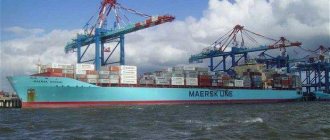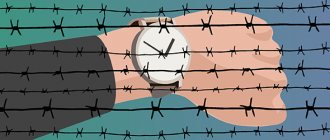1. Violation of traffic safety rules and operation of railway, air, sea and inland water transport and the metro by a person who, by virtue of the work performed or position held, is obliged to comply with these rules, except for the cases provided for in Article 271.1 of this Code, as well as the refusal of the specified person to comply of their labor duties in cases where such refusal is prohibited by law, if these acts negligently entailed the infliction of grave harm to human health or the infliction of large damage, - shall be punishable by a fine in the amount of one hundred thousand to three hundred thousand rubles or in the amount of the wages or other income of the person convicted of a period of one to two years, or restriction of freedom for a term of up to four years, or forced labor for a term of up to two years with deprivation of the right to hold certain positions or engage in certain activities for a term of up to three years or without it, or arrest for a term of up to six months, or imprisonment for a term of up to two years with or without deprivation of the right to hold certain positions or engage in certain activities for a term of up to three years.
2. The same acts, which through negligence resulted in the death of a person, are punishable by forced labor for a term of up to five years or imprisonment for the same term.
3. Acts provided for in the first part of this article, which through negligence resulted in the death of two or more persons, are punishable by forced labor for a term of up to five years or imprisonment for a term of up to seven years.
Note. In this article, major damage is defined as damage the amount of which exceeds one million rubles.
Why is violating traffic rules so dangerous?
Violations of traffic rules are dangerous not only because they lead to the death of people, harm their health and property. Any, even the most insignificant, deviation from the rules, especially if it goes unnoticed by traffic police officers, instills in the driver a feeling of impunity and irresponsibility. And this, in turn, increases the risk for people and cars around him to get into an unpleasant situation. That is why it is so important that not a single culprit can escape responsibility for violating traffic rules, and compliance with them should become a natural need of every person, be it a driver of a vehicle (vehicle), a passenger or a pedestrian.
Civil responsibility
This type of liability occurs if the driver, as a result of violating traffic rules, caused material damage to third parties. Punishment for violating traffic rules will be in the form of an administrative fine and compensation for damage to the injured party.
The driver is obliged to compensate for moral and material damage, as well as pay compensation for lost profits in connection with the accident to the injured person, if his work is carried out at the expense of the damaged vehicle.
He is obliged to compensate expenses if the violation of traffic regulations was on his part, and he personally drove the vehicle.
The legislative framework
Criminal and administrative liability for violation of traffic rules is provided for in the relevant articles of Chapter. 27 of the Criminal Code of the Russian Federation and Ch. 12 Code of Administrative Offenses of the Russian Federation. In 13 articles ch. 27 of the Criminal Code of the Russian Federation stipulates such crimes against road safety, such as:
- violation of traffic rules or operation of a vehicle, leading to harm to health or death of one or more people (Article 264);
- driving a vehicle while intoxicated by a person who has previously been brought to administrative responsibility or has a criminal record (Article 264.1).
In turn, Ch. 12 of the Code of Administrative Offenses of the Russian Federation contains more than 40 articles establishing liability for traffic offenses, for example, for:
- driving a vehicle without mandatory documents (Article 12.3);
- driving a vehicle while intoxicated (Article 12.8);
- violation of the speed limit (exceeding the permissible speed, Art. 12.9);
- violation of maneuvering rules (Article 12.4);
- refusal to give way to pedestrians (Article 12.18).
Compound
The topic of this article, as well as the main question of interest, is what liability occurs in case of non-compliance with traffic rules. Due to the fact that thousands of such violations are recorded every day throughout the country, and that the actual consequences of these violations can range from minimal damage to death, the current legislation provides for as many as three possible types of liability: civil, administrative and criminal. And it is these types that will be discussed further.
Civil responsibility
Surely many people know that civil law regulates certain property and non-property relations of subjects. In relation to the topic under consideration, civil liability arises if a violation of traffic rules led to actual losses (damage) to one of the entities. It should be understood that the Civil Code, Article 1079 and Chapter 59 as a whole, determined that liability extends not only to the person who directly participated in the act, but also to the person who is the actual owner of the instrument for committing the crime (the owner of the vehicle).
That is, if someone provided their car to a third party for use, even if it is a close relative, and the person who received the legal right to use the vehicle violated traffic rules and this led to the emergence of civil legal relations, then the owner (under certain circumstances) will be obliged to compensate part of the damage caused. This obligation does not apply to cases where the owner did not give permission (and this will be proven) to drive his vehicle. That is, in essence, it should be regarded as theft or theft. From the above it follows that civil liability consists of repayment of damage caused as a result of an accident on the basis of a corresponding statement of claim from the victim.
Criminal liability
Why will we first talk about criminal and not administrative liability? Of course, the Criminal Code in its norms provides for more severe forms of punishment than the Administrative Code.
But unlike the Code of Administrative Offenses of the Russian Federation, which, looking ahead, is the main legal act on the topic under consideration, the Criminal Code of the Russian Federation contains only a few articles that provide for criminal liability and punishment for violating traffic rules.
So, here and further, the articles responsible for establishing punishment for various types/consequences of violation of traffic rules, due to their large number, should be presented in the form of a table, namely:
Article of the Criminal Code of the Russian Federation Brief content/type of violation Punishment Part 1 of Article 264 Violation by the driver of a mechanical vehicle, resulting in serious harm to health, committed through negligence.
- Restriction of freedom - up to 3 years.
- Forced labor - up to 2 years.
- Arrest for up to 6 months. Imprisonment – up to 2 years.
Additional - official or active ban for up to 3 years.
Part 2 of Article 264 A similar act committed while intoxicated.
- Forced labor - up to 3 years.
- Imprisonment for up to 4 years.
Additional - official or active ban for up to 3 years.
Part 3 of Article 264 A similar act provided for in Part 1, if it resulted in death due to negligence.
- Forced labor - up to 4 years.
- Imprisonment for up to 5 years.
Additional - official ban for up to 3 years.
Part 4 of Article 264 A similar act provided for in Part 2, if it resulted in death due to negligence. Imprisonment for a term of 2 to 7 years.
Additional - official or active ban for up to 3 years.Part 5 of Article 264 A similar act provided for in Part 1, if it resulted in the death of two or more persons due to negligence.
- Forced labor - up to 5 years.
- Imprisonment for up to 7 years.
Additional - official or active ban for up to 3 years.
Part 6 of Article 264 A similar act provided for in Part 2, if it resulted in the death by negligence of two or more persons. Imprisonment for a term of 4 to 7 years.
Additional - official or active ban for up to 3 years.Article 264.1 Driving a mechanical vehicle while intoxicated by a person who has already been subjected to administrative punishment for a similar offense.
- Fine - from 200,000 to 300,000 rubles.
- Mandatory work - up to 480 hours.
- Forced labor - up to 2 years.
- Imprisonment for up to 2 years.
Additional - official or active ban for up to 3 years.
As can be seen from the above provisions, criminal liability under these standards presupposes that the guilty person has no direct intent to cause harm to human health or cause death. If the person who violated the traffic rules intentionally used the vehicle, for example, for murder, then the qualification will be based on the provisions of Part 1 of Article 105 of the Criminal Code of the Russian Federation, and under certain circumstances, under paragraph “e” of Part 2 of Art. 105 of the Criminal Code of the Russian Federation.
Administrative responsibility
As already mentioned, it is the Administrative Code that is the most complete “collection” of norms provided for by current legislation and responsible for imposing punishment for non-compliance with traffic rules. In total, there are 42 articles of the Code of Administrative Offenses of the Russian Federation (Chapter 12), which are divided into many different types of traffic violations under consideration. Here are just a few of them:
Article
of the Code of Administrative Offenses of the Russian FederationBrief content/type of violation Administrative
punishment12.1
- Driving a vehicle that is not duly registered.
- Driving a vehicle that has not passed state technical inspection.
- Driving a vehicle that has not passed technical inspection.
Fine from 500 to 800 rubles.
In case of repeated violation, up to 5,000 rubles or deprivation of the right to drive a vehicle for a period of 1 to 3 months.12.3 Driving a vehicle by a driver who does not have with him the documents provided for by the Traffic Rules (driver's license, vehicle registration documents, as well as other documents provided for by the Decree of the Government of the Russian Federation of October 23, 1993 N 1090 “On the Traffic Rules”, Chapter 2).
- Fine 500 rubles.
- A fine of 5,000 rubles for providing passenger transportation services without the appropriate permit.
- A fine of 3,000 rubles for transferring control of a vehicle to a person who does not have the appropriate documents.
12.6 Violation of the rules for using seat belts or motorcycle helmets. Fine 1000 rubles. 12.8 Driving a vehicle by a driver who is in a state of intoxication, transferring control of a vehicle to a person who is in a state of intoxication.
- Fine 30,000 rubles.
- Administrative arrest for 15 days for driving a vehicle while intoxicated and without a license.
12.9 Exceeding the set speed:
- from 20 to 40 km/h (part 2);
- from 40 to 60 km/h (part 3);
- from 60 to 80 km/h (part 4);
- more than 80 km/h (part 5);
- repeated violation of part 3;
- repeated violation of parts 4 and/or 5.
- Fine 500 rubles.
- Fine from 1000 to 15000 rubles.
- Fine from 2000 to 2500 rubles.
- Fine 5,000 rubles/deprivation of rights for 6 months.
- Fine from 2000 to 2500 rubles.
- Deprivation of rights for 1 year/fine 5000 rubles.
12.12 Driving through a prohibiting traffic light or a traffic controller's prohibiting gesture. Fine from 800 to 5000 rubles.
Deprivation of rights from 4 to 6 months.12.14 Violation of maneuvering rules. Fine 500 rubles. 12.19 Violation of the rules of stopping or parking vehicles. Fine from 500 to 5000 rubles. 12.23 Violation of the rules for transporting people. The fine for individuals is up to 5,000 rubles.
The fine for officials is 50,000 rubles.The fine for legal entities is up to 100,000 rubles.
12.25 Failure to comply with the requirement to provide a vehicle or to stop a vehicle. Fine from 500 to 800 rubles. 12.28 Violation of the rules established for the movement of vehicles in residential areas. Fine from 1000 to 3000 rubles. 12.36.1 Violation of the rules for using a telephone by the driver of a vehicle. Fine 1000 rubles. 12.37 Failure to comply with the requirements for compulsory civil liability insurance of vehicle owners. Fine from 500 to 800 rubles.
This table provides a list of 14 main violations that are recorded by traffic police officers daily.
Administrative liability for traffic violations
Administrative offenses in the field of road traffic entail liability under the relevant articles of Chapter. 12 Code of Administrative Offenses of the Russian Federation. Violators are “caught” not only by traffic police officers, but also by cameras recording traffic violations. Drivers of vehicles are held accountable, and administrative liability for violation of traffic rules is established for pedestrians and passengers (Articles 12.29, 12.30).
For administrative offenses provided for in Ch. 12 of the Code of Administrative Offenses of the Russian Federation, the following sanctions are mainly applied:
- warning;
- fines for traffic violations;
- administrative arrest;
- deprivation of driver's license.
Road accidents involving minors
Unfortunately, in the Russian Federation a huge number of minors die every year, either as direct participants/perpetrators of road accidents or as victims. This mainly happens due to the low legal culture of citizens, especially the younger generation of their parents, who buy mopeds, scooters and motorcycles for their children without first taking care of the need to instill driving skills and an understanding of the current legal norms. Of course, minors should and will bear due responsibility for failure to comply with traffic rules, but due to the age restrictions above, the range of qualification standards is limited. For example, this could be a qualification under Article 12.7 of the Administrative Code on Offenses and a fine of 5,000 to 15,000 rubles.
Grounds for criminal prosecution under Article 264 of the Criminal Code of the Russian Federation
For gross violations of traffic rules, criminal liability arises for the driver. Let us consider the features of the crime for which criminal liability arises under Art. 264 of the Criminal Code of the Russian Federation. This article establishes penalties for vehicle drivers whose careless (frivolous, negligent) actions caused harm to health or led to the death of one or more people. For clarity, the types of this crime are shown in the table.
| Corpus delicti | What is provided | |
| Without aggravating circumstances | With aggravating circumstances | |
| Violation of traffic rules resulting in serious harm to health | part 1 | part 2 |
| Violation of traffic rules resulting in the death of a person | Part 3 | part 4 |
| Traffic violation resulting in the death of two or more people | part 5 | Part 6 |
Aggravating circumstances in Art. 264 of the Criminal Code of the Russian Federation are considered:
- Drunk;
- leaving the scene of an accident by the vehicle driver.
The qualifying signs of grave harm are prescribed in the Rules for determining the severity of harm caused to human health, which are approved by Decree of the Government of the Russian Federation of August 17, 2007 No. 522. These, in particular, include:
- loss of vision, speech, hearing, any organ, loss of an organ’s functions;
- abortion;
- mental disorder;
- permanent facial disfigurement;
- significant permanent loss of general ability to work by at least 1/3;
- complete loss of professional ability to work.
After committing a crime under Article 264 of the Criminal Code of the Russian Federation, you need to call the traffic police and report the accident. You can also file a statement about traffic violations in person at the traffic police department or online on the department’s website. Based on the application, an investigation will be conducted and the case will be sent to court to punish the culprit of the accident. In addition, the case materials should be used to bring a civil claim against the culprit in order to obtain compensation from him or to submit an application to the insurance company if the life and/or health of the victim was insured.
What is the penalty for violating traffic rules?
As mentioned above, for administrative offenses in the field of road safety, vehicle drivers, pedestrians and passengers are warned, fined and arrested, and drivers are also deprived of their rights. The option of punishment and its degree (amount of fine, period of arrest or deprivation of a driver's license) is determined by an authorized person (traffic police officer, judge) depending on the type of offense and the specific circumstances under which it was committed.
To illustrate, let’s consider what sanctions a driver faces if he drives drunk (such an offense and liability for it are provided for in Article 12.8 of the Code of Administrative Offenses of the Russian Federation, and the driver’s actions should not contain signs of a criminal act):
- for driving a vehicle or transferring control of a vehicle to another person who is drunk, a fine of 30,000 rubles plus deprivation of rights from 1.5 to 2 years (parts 1, 2);
- for driving a vehicle by a person who does not have or has been deprived of rights, arrest from 10 to 15 days, and for those who cannot be arrested, a fine of 30,000 rubles.
For a driver prosecuted for a traffic violation in 2022, the penalties are much more severe. Thus, criminal liability for violating traffic rules under Art. 264 of the Criminal Code provides for such punishment options as restriction of freedom, forced labor, arrest, imprisonment (compulsory labor is not awarded as punishment).
Punishments for violating traffic rules under Article 264 of the Criminal Code of the Russian Federation are given in the table.
| Corpus delicti | Punishment, statute of limitations | |
| Without aggravating circumstances | With aggravating circumstances | |
| Violation of traffic rules resulting in serious harm to health | Part 1:
Limitation period – 2 years | Part 2:
Limitation period – 6 years |
| Violation of traffic rules resulting in the death of a person | Part 3:
Limitation period – 6 years | part 4:
Limitation period – 10 years |
| Traffic violation resulting in the death of two or more people | Part 5:
Limitation period – 6 years | part 6:
Limitation period – 10 years |
General provisions
So, in the Russian Federation, in accordance with current legislation, it is allowed to undergo training to drive a car and/or motorcycle from the age of 16. And the actual receipt of a legal permit to drive a vehicle will depend on the requested category, namely:
- categories “M” and “A1” - that is, mopeds and motorcycles up to 125 kb/s. – it is possible to obtain a license at the age of 16 years, but it is possible to transport passengers only with at least 2 years of experience;
- categories “A”, “B”, “C”, “B1”, “C1” - motorcycles, cars, including trucks - only from 18 years of age;
- categories “D”, “D1”, “Tm” and “Tb” - passenger cars with more than 8 seats - only from 21 years of age;
- categories “BE”, “CE”, “DE” - cars with trailers - to obtain a license you must have at least 1 year of driving experience in the main category;
- categories “C1E” and “D1E” – vehicle weight from 3.5 to 7.5 tons – similar requirements.
Accordingly, failure to comply with this age limit creates one of the types of violations of current traffic rules. In general, the legislative system in terms of ensuring road safety includes a huge number of regulations, which creates an even greater number of possible forms.
Prevention of violations
Prevention of traffic accident violations is one of the components of the activities of traffic police departments. Its goal is to reduce the level of accidents on the roads. Activities to prevent traffic violations are carried out with various categories of the population, including children in schools and drivers, including traffic rule violators. They are provided with information about the rules of behavior on the roads, safety requirements, and the consequences of violating traffic rules.
Preventive measures also include an analysis of the condition of roads and the accident rate of their sections. The traffic police are taking measures to inform drivers and local authorities, mark problem areas and/or fence them off.






